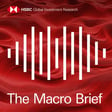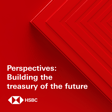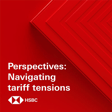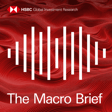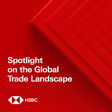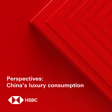Become a Creator today!Start creating today - Share your story with the world!
Start for free
00:00:00
00:00:01

COP26 preview, ECB reaction, FX update and India’s ‘new’ economy - HSBC Global Research
In this edition we look at what to expect from the crucial COP26 climate negotiations, consider changes to the ECB’s bond buying programme, assess the outlook for the USD and examine two ‘new’ growth drivers in India. Disclaimer.
To stay connected and to access free to view reports and videos from HSBC Global Research click here.
Hosted on Acast. See acast.com/privacy for more information.
Transcript
Introduction to HSBC Global Viewpoint
00:00:00
Speaker
This is HSBC Global Viewpoint, your window into the thinking, trends and issues shaping global banking and markets.
00:00:09
Speaker
Join us as we hear from industry leaders and HSBC experts on the latest insights and opportunities for your business.
00:00:17
Speaker
Thank you for listening.
00:00:22
Speaker
You're
Macro Viewpoint Overview and Key Topics
00:00:23
Speaker
listening to the HSBC Global Research Macro Viewpoint, our weekly review of the important work by our global team of economists and strategists.
00:00:34
Speaker
Coming up this week, the countdown is underway to global climate negotiations in Glasgow.
00:00:39
Speaker
We're looking at what may matter most to investors about the COP26 summit.
00:00:44
Speaker
The European Central Bank is making changes to its bond buying program, and that may have market implications.
00:00:50
Speaker
We're also tracking the dollar and the economy in India, where two new sources of growth are getting special attention.
00:00:56
Speaker
This podcast was recorded on the 9th of September.
00:00:59
Speaker
Our full disclosures and disclaimers must be viewed on the link attached to your media player.
00:01:05
Speaker
I'm P.S.
00:01:05
Speaker
Butler.
00:01:06
Speaker
And I'm Chris Brown-Humes.
00:01:07
Speaker
And
Significance and Goals of COP26
00:01:08
Speaker
we begin this week with the climate.
00:01:09
Speaker
From flooding in New York to wildfires in Greece, extreme events have been all over the news in the past few months.
00:01:16
Speaker
All of which makes the forthcoming COP26 meeting in Glasgow even more crucial in getting the world onto a net zero emissions trajectory by 2030.
00:01:24
Speaker
Weixin Chan is our head of ESG research and he joins us now to explain what we should expect from the summit.
00:01:32
Speaker
Weixin, can you start by reminding us about the targets that were set at the Paris Agreement and where we are in achieving them?
00:01:39
Speaker
The Paris Agreement was adopted in 2015 and the main goals that they have for that are to limit temperature rises from pre-industrial times to well below two degrees and even better one and a half degrees in the future.
00:01:53
Speaker
Now we're not really on track to do that to be honest with you and one of the main goals of COP26 will be to get us back on track and what does it mean to be back on track?
00:02:02
Speaker
It means
00:02:03
Speaker
reducing emissions by 45% by 2030 and then hitting net zero by 2050.
00:02:09
Speaker
But at the moment, we're far, far away from doing that.
Outcomes and Implications of COP26
00:02:12
Speaker
What are the best and worst case scenarios that could emerge from the summit?
00:02:15
Speaker
A successful COP26 would mean there is much more clarity on global climate policies and this could unlock investment into building resilience and innovation and new decarbonisation technologies, which would be fantastic.
00:02:28
Speaker
A failure at COP26, however, would lead to continued, if not more uncertainty,
00:02:34
Speaker
over the speed of development towards a low carbon transition.
00:02:39
Speaker
And this would mean companies would not be willing to invest and the disclosure wouldn't be there and in general would be much more susceptible to the impacts of climate change.
00:02:48
Speaker
And what are
Critical COP26 Discussions: Finance and Pledges
00:02:49
Speaker
the key talking points that are ultimately going to determine whether the summit is successful?
00:02:54
Speaker
Well, success depends on where your perspective is, but there are three main things to look out for COP26.
00:02:59
Speaker
The first would be Article 6 of the Paris Agreement.
00:03:02
Speaker
This is an issue that's been unresolved for a number of years now.
00:03:05
Speaker
It's essentially how various countries can trade what they call emissions reductions or mitigation obligations, either directly, that's bilaterally between countries, or through a market mechanism.
00:03:17
Speaker
So there's a lot of issues to be resolved on that particular point there.
00:03:22
Speaker
The second would be on finance, specifically climate finance, the flow of finance between developed towards developing economies.
00:03:32
Speaker
Now the number to look out for is $100 billion per year from 2020.
00:03:37
Speaker
I know we're in 2021 and this has not been met in recent years.
00:03:42
Speaker
Finance is often traded for promises, so definitely something to watch out for.
00:03:46
Speaker
And the third thing to look out for would be what they call the common timeframes of climate pledges.
00:03:52
Speaker
So this is about how long the climate pledges from various countries should last.
00:03:57
Speaker
Should they last five years or should they last 10 years?
00:04:00
Speaker
Now, there are various nuances surrounding that, but it really matters depending on whether you are a developed economy or a developing economy.
00:04:08
Speaker
Among all the acronyms surrounding COP26, and there are a lot of them, one that seems to be generating a lot of buzz at the moment is O-M-G-E.
Climate Integrity and Article 6
00:04:17
Speaker
Tell us what that is.
00:04:18
Speaker
O-M-G-E stands for the overall mitigation of global emissions.
00:04:23
Speaker
It's about ensuring that all the decisions that we take, all the actions that we take, actually result in a reduction in global emissions and do not involve things like carbon leakage or the non-reduction of emissions in one place versus another.
00:04:39
Speaker
So it's really about embedding climate integrity to the entire system.
00:04:44
Speaker
It applies very, very much to Article 6, and the negotiators are thinking about making it apply to other parts of the Paris Agreement.
00:04:51
Speaker
That could make the discussions very, very interesting indeed.
00:04:54
Speaker
Weixin, thanks very much.
00:04:56
Speaker
Thank you for having me, as always.
00:05:00
Speaker
Here at HSBC Global Research, we aim to provide the best analysis of climate change and its implications for economies, industries and sectors.
00:05:08
Speaker
We'll be publishing a lot more on the subject ahead of the COP26 summit, so be sure to keep a lookout for more from the team over the coming weeks.
ECB Meeting and Asset Purchase Decisions
00:05:17
Speaker
This week, all eyes were on the ECB meeting, where the central bank was due to decide whether to reduce the pace of its asset purchases.
00:05:24
Speaker
Simon Wells, Chief European Economist, is here to update us on the outcome.
00:05:28
Speaker
So, Simon, what did the ECB announce today?
00:05:31
Speaker
Well, it dropped the significantly higher purchase pace from its policy statement.
00:05:36
Speaker
It now favours a moderately lower pace of net asset purchases under its pandemic emergency purchase programme,
00:05:44
Speaker
than in the previous two quarters of the year.
00:05:47
Speaker
So it's dialed down asset purchases very slightly.
00:05:51
Speaker
ECB President Christine Lagarde explained that this is because it thinks it can maintain favourable financing conditions at this lower purchase pace.
00:06:01
Speaker
Now, of course, in practice, what it was doing was only making official what has already happened in practice, because through the summer, the purchase pace already declined to about 15 billion a week.
00:06:14
Speaker
And that was down from a peak of over 20 billion a few weeks ago and has already taken the purchase pace through the summer back to levels it was around the turn of the year.
00:06:24
Speaker
Otherwise, policy rates, forward guidance, they were all unchanged as widely expected.
00:06:29
Speaker
But you've got this a taper that's not a taper.
00:06:32
Speaker
What do you mean?
00:06:33
Speaker
Well,
ECB's Challenges with Inflation Targets
00:06:34
Speaker
it's not really a proper taper in the sense that this is not the beginning of a plan to reduce net asset purchases to zero.
00:06:42
Speaker
This is an adjustment to the PEP in response to financing conditions.
00:06:48
Speaker
But even if PEP ends next March, as is currently planned, the regular asset purchase program, the APP,
00:06:56
Speaker
will continue and will continue indefinitely.
00:07:00
Speaker
So this isn't a taper in that net asset purchases are likely to end anytime soon.
00:07:06
Speaker
And Christine Lagarde was very clear about this in the press conference when she said the lady isn't for tapering.
00:07:12
Speaker
So does the slower pace of bond purchases jar with the strategic commitment that the ECB gave not that long ago for forceful and persistent monetary support?
00:07:22
Speaker
Well, of course, this is the communication challenge that the ECB faces.
00:07:26
Speaker
On the one hand, the PEP program very clearly is about maintaining financing conditions.
00:07:32
Speaker
And if you look purely at those, there was really not much justification for
00:07:37
Speaker
for continuing with the significantly higher purchase pace.
00:07:40
Speaker
On the other hand, even after today's revised forecast, in 2023, the ECB projects inflation to be just one and a half percent.
00:07:49
Speaker
So well below its two percent symmetric target.
00:07:54
Speaker
So in that sense, it's a problem.
00:07:56
Speaker
But the initial market reaction hasn't been too harsh.
00:08:00
Speaker
And that may well be because the ECB just moderately lowered the pace.
00:08:06
Speaker
But for sure, this is the challenge it faces.
00:08:09
Speaker
And finally, Simon, we had some new growth and inflation forecasts from the bank today.
00:08:14
Speaker
Any particular highlights there?
00:08:15
Speaker
Well,
Market Doubts on Fed and Dollar Impact
00:08:16
Speaker
as I said, they nudged up inflation very slightly in the medium term, but it's still well below target.
00:08:22
Speaker
That, I think, means that our view remains that if PEP does end next March, they will ramp up the regular asset purchase programme,
00:08:33
Speaker
in order to continue to provide support for the market.
00:08:36
Speaker
On growth, they revised up this year fairly significantly, so from 4.6% to 5%.
00:08:44
Speaker
That's very close to our own forecast of 4.9%.
00:08:48
Speaker
Next year, they nudge down from 4.7% to 4.6%.
00:08:52
Speaker
That's a little bit above the 4% growth that we see.
00:08:56
Speaker
But still, for now, they see the recovery as broadly on track.
00:09:01
Speaker
Simon, thank you so much for that summary.
00:09:03
Speaker
Thank you.
00:09:06
Speaker
We turn to the currency markets now, where our team have just published the latest monthly roundup of their views.
00:09:12
Speaker
Paul Mackle is Global Head of FX Research, and he spoke earlier to Graham Mackay about the key themes in the report.
00:09:18
Speaker
Paul, welcome to the podcast.
00:09:19
Speaker
Thank you very much.
00:09:20
Speaker
Now, Waves of Doubt is the title of your latest currency outlook.
00:09:25
Speaker
What are these waves?
00:09:26
Speaker
Where do they exist?
00:09:27
Speaker
Well, what we're exploring in this edition is we're focused on a lot of the doubts that many market participants have lately, how they're viewing the Fed, how they're viewing tapering, how they're viewing the outlook for the dollar.
00:09:42
Speaker
And as I said, I mean, there's lots of doubts associated with this.
00:09:45
Speaker
More specifically, with regards to the Fed, does it even matter?
00:09:50
Speaker
Are they going to be dovish against the backdrop of a challenging COVID situation and some surprising problems?
00:09:56
Speaker
data to the downside that's been developing over the last month or so.
00:10:01
Speaker
And then there's another source of doubt reference to the Fed and that does tapering even matter for the FX market?
00:10:08
Speaker
And will this play against the dollar being able to recover over time?
00:10:14
Speaker
So as I said, we go through a number of these issues.
00:10:17
Speaker
My thinking first and foremost is that when the Fed does begin to taper its balance sheet, it's very different from what
00:10:24
Speaker
how they were outlining it in late 2013.
Fed Tapering and Currency Markets
00:10:27
Speaker
And it'll be emphasizing policy divergence.
00:10:31
Speaker
That is a very big force that is playing out in the currency market and we think should be gradually leading to the dollar to strengthen over time.
00:10:40
Speaker
And just on the topic of the dollar, remind us what your framework is there.
00:10:44
Speaker
Well, we've been focusing on two specific drivers.
00:10:48
Speaker
One is a function of the ebb and flow of global growth.
00:10:52
Speaker
When global growth is accelerating, we've been saying for quite some time that typically the dollar weakens and the opposite should also hold true.
00:11:00
Speaker
So now that global growth appears to be losing some steam, that should be playing to the dollar's fortune.
00:11:07
Speaker
The other part of our framework is associated with the Fed, as I had suggested.
00:11:12
Speaker
That tapering itself, I think, will matter primarily versus some of the other low yielding currencies or major currencies.
00:11:19
Speaker
Yes, it has begun for some other central banks, but it will bring into focus whether the Fed's forward guidance could potentially change and that could lead to more volatility in the FX market and again, play to the dollar's strength.
00:11:33
Speaker
All right.
00:11:34
Speaker
And there's another aspect to the dollar and the Fed discussion in this report, and that concerns the digital dollar and the outlook for that over the coming quarters.
00:11:44
Speaker
Can you just summarize your views on where we're heading?
Digital Dollar Debate
00:11:48
Speaker
Yes, you're absolutely right.
00:11:49
Speaker
There is a growing debate amongst U.S. officials whether to have a central bank digital currency.
00:11:55
Speaker
There's very clear pros and cons in their view.
00:11:59
Speaker
But some proponents seem to emphasize the need to have a more efficient payment system.
00:12:05
Speaker
So that's a similar message from other central banks that are going down this road of having a central bank digital currency.
00:12:13
Speaker
such as the PBOC's ECNY or the European Central Bank's potential digital euro.
00:12:19
Speaker
Again, there are various motivations about why to have a central bank digital currency, but this seems to be highlighted by some of the Fed officials.
00:12:27
Speaker
Some of the motivations are also being highlighted by different working groups, and one that has stood out is the digital dollar project.
00:12:36
Speaker
They've been deeper in terms of their thinking about the need for a central bank digital currency.
00:12:42
Speaker
And one of the arguments is related to the dollar's reserve status.
00:12:46
Speaker
And they believe that actually a central bank digital currency in the form of the dollar, that is, would help to enhance or protect its reserve currency position.
00:12:57
Speaker
And just before we go, remind us where the U.S. is in terms of the advancement of a digital currency, because actually compared to some other major economies, it's a little ways behind, isn't it?
00:13:10
Speaker
Indeed it is.
00:13:11
Speaker
And I think that as long as this debate continues, then it's going to keep the U.S. potentially on the back foot or as a laggard until they better identify what they want to do.
00:13:22
Speaker
with this digital dollar.
00:13:24
Speaker
This very much stands in contrast to China.
00:13:27
Speaker
The PBOC is very much determined to roll out the ECNY in the not too distant future.
00:13:35
Speaker
Its trials have been accelerating and the technical features and architecture of the ECNY have been also becoming a lot more complex.
00:13:44
Speaker
it tells us that we're getting closer to an official launch.
00:13:48
Speaker
And as I said, that stands very much in contrast to a potential digital dollar, which is well into the future.
00:13:56
Speaker
All right.
00:13:56
Speaker
Well, watch this space.
00:13:57
Speaker
Paul Mackel, thank you very much indeed.
00:13:59
Speaker
Thank you very much.
India's Growth Drivers: Exports and Tech Firms
00:14:02
Speaker
We finish off in India, where Pranjal Bhandari, Chief India Economist, has been looking at two new growth drivers that are supporting the country's recovery.
00:14:11
Speaker
She joins me now from Mumbai.
00:14:13
Speaker
Pranjal, welcome to the podcast.
00:14:14
Speaker
Great to be here, Piers.
00:14:16
Speaker
Pranjal, in your new report, what do you mean by India's new economy?
00:14:22
Speaker
Yes.
00:14:23
Speaker
So, you know, ever since the pandemic, we've seen two new growth drivers have emerged in the economy.
00:14:28
Speaker
One is exports.
00:14:29
Speaker
Exports have been growing rather briskly.
00:14:32
Speaker
And the second is the growing ecosystem around new age technology firms.
00:14:37
Speaker
Many new ones are coming, they're mushrooming, and they're also attracting a lot of finance.
00:14:41
Speaker
So let's take a look at exports.
00:14:43
Speaker
Firstly, what do you think is leading to the rise in exports?
00:14:47
Speaker
Yeah, so just to put it in context, you know, exports are currently 17% higher than they were pre-pandemic.
00:14:54
Speaker
This year, 2021 alone, they've grown 36% quarter-on-quarter annualized.
00:14:59
Speaker
And, you know, that's not it.
00:15:00
Speaker
We find that they've been strong since 2017.
00:15:02
Speaker
You know, we call this whole period since 2017 a trade diversification period when a lot of corporates were looking to diversify out.
00:15:12
Speaker
And I think India was a beneficiary in few sectors.
00:15:15
Speaker
For instance, high-skill exports,
00:15:17
Speaker
We find that the exports of mobile phones, machinery, pharmaceutical products, IT services have gained global market share.
00:15:26
Speaker
But unfortunately, low skill labor intensive exports like textiles and agriculture haven't done as well.
00:15:33
Speaker
You know, they've been rather weak.
00:15:35
Speaker
Putting it all together, there is econometric evidence that there has been a net gain.
00:15:39
Speaker
So high tech gain has been higher than the loss in low tech exports.
00:15:44
Speaker
But the challenge now is that over the next couple of years, India really needs to raise its low skill labor intensive exports as well.
00:15:53
Speaker
So can new age tech firms really be the sort of major contributor to raising India's GDP growth?
Tech Firms and India's GDP Growth
00:16:00
Speaker
Yeah, so that's a second road driver, new age technology firms.
00:16:04
Speaker
Now the stars seem to have aligned there.
00:16:06
Speaker
There is a huge amount of appetite to fund these companies, the global liquidity, some geopolitical changes globally.
00:16:15
Speaker
And even back in the
00:16:16
Speaker
In India, there's been a huge proliferation of these firms.
00:16:20
Speaker
Many of them have been started over the last two to three years.
00:16:24
Speaker
We are seeing a huge increase in all kinds of inflows, FDI, FII, venture capital, private equity.
00:16:31
Speaker
Currently, 50% of India's FDI inflows are digital.
00:16:35
Speaker
as opposed to 20% about six, seven years ago.
00:16:38
Speaker
And I think all of this is good for the overall economy.
00:16:41
Speaker
It does lead to a pro entrepreneurship cultural shift.
00:16:45
Speaker
It creates jobs.
00:16:46
Speaker
It also adds to growth.
00:16:48
Speaker
In fact, we assess that just e-commerce alone
00:16:52
Speaker
could add 25 basis points, that's 0.25 percentage points to India's GDP growth per year over the next decade, which is substantial.
00:17:02
Speaker
So there can be some big gains coming from there.
00:17:06
Speaker
The only problem is that these new age firms will also be big users of India's physical economy.
00:17:12
Speaker
You know, it's infrastructure, it's roads, rails, and also it's manufacturing sector.
00:17:17
Speaker
After all, they'll be selling things that are manufactured in the country.
00:17:21
Speaker
And therefore, it's very important for the physical economy to keep up with the digital economy.
00:17:27
Speaker
So on that point, do you see that as being able to keep up or will that act as a constraint?
00:17:32
Speaker
Well, that is something you'll have to wait and watch.
00:17:35
Speaker
Both the drivers,
Infrastructure's Role in Tech Growth
00:17:36
Speaker
exports and the rise in new age tech firms have a lot in common.
00:17:40
Speaker
They both can be big users of India's inherent endowment, which is its big labor force.
00:17:45
Speaker
They both can benefit a lot from big global changes.
00:17:49
Speaker
But the big constraint they may face is the physical economy.
00:17:52
Speaker
There has been some good news there.
00:17:55
Speaker
For example, this year, government has spent a lot on infrastructure, roads and railways.
00:18:00
Speaker
It also has plans to spend a lot more over the next couple of years.
00:18:04
Speaker
But that's one area we'll be really watching to ensure that the physical economy keeps up.
00:18:10
Speaker
Pranjal, thank you very much.
00:18:11
Speaker
Great to be here.
Podcast Wrap-up and Further Resources
00:18:14
Speaker
So that's it for today's program.
00:18:16
Speaker
Thank you to our guests, Wei-Shin Chan, Simon Wells, Paul Mackle, and Pranjal Bhandari.
00:18:21
Speaker
We hope you found today's podcast useful.
00:18:23
Speaker
From all of us on the team, thanks for listening.
00:18:25
Speaker
Please join us next week for another edition of the Macro Viewpoint.
00:18:34
Speaker
Thank you for listening today.
00:18:36
Speaker
This has been HSBC Global Viewpoint Banking and Markets.
00:18:40
Speaker
For more information about anything you heard in this podcast or to learn about HSBC's global services and offerings, please visit gbm.hsbc.com.
